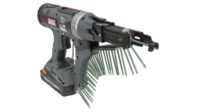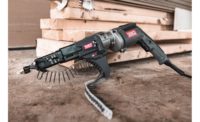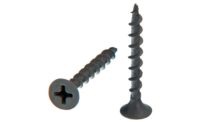Every few decades an innovation comes along that completely changes the contracting landscape. I’m not referring to the near-constant cycle of power tool updates, or forward-thinking new building materials that aren’t yet cost-effective to manufacture or use. Rather, I’m talking about true generational leaps—such as the transition from plaster to drywall, or the adoption of screwdrivers over a hammer and nails—that set new standards for productivity, durability, ease of install and affordability.
In the realm of drywall, I would argue that auto-feed screwdrivers are close to a generational leap, although it took years of incremental updates to get here. Recent design updates have all but eliminated the “finicky-ness” that pros once associated with collated screw systems, such as jams, incomplete drives and other limitations. In the absence of those drawbacks, auto-feed screwdrivers are almost different tools altogether—one that should be in every drywaller’s toolbox. No matter how fast you can attach a sheet of drywall using a traditional driver and bulk screws, you can do it better and faster with an auto-feed drywall screwdriver.
If you haven’t considered auto-feed systems for yourself or your subcontractors in a few years, it’s time to look again. Here are a few new ways to think about collated screw systems, and why 2021 is the year to upgrade.
Affordable Options and Attachments
Auto-feed screw systems cost approximately twice as much as standard drivers. That can be a tough pill to swallow, despite the fact that pros who hang drywall day in and day out typically quickly see a return on investment. However, as auto-feed systems have become more ubiquitous, they are certainly more affordable today than 20 years ago. Additionally, there are always opportunities to reduce upfront costs.
For those who already have invested in drywall drivers, many brands make collated attachments that are less costly than purchasing a complete collated system upfront. SENCO makes collated attachments for several common brands of drivers. Corded tools often cost less upfront than cordless models, and sales are easy to come by. In short, for those willing to find the right balance between features and cost, or wait for the best deal, there is always a bargain to be found.
Reducing Human Factors
The most effective tools and technologies presuppose users will make mistakes and proactively prevent them from doing so. The auto-correct feature on your smartphone is one example. The medical field is full of examples, as even a small mistake can create catastrophic outcomes. Auto-feed drywall drivers are as close to this type of technology as you can find for attaching drywall.
A locking, adjustable depth-of-drive will improve consistency, completely preventing over- or under-driving screws. Plastic collation prevents dropping, requiring fewer screws and less cleanup. One-handed operation frees up the user to make minor adjustments to the sheet for tight, square joints. The collation process itself reduces fastener defects, as defective screws are easily spotted during manufacturing, unlike bulk screws. Everyone, in every profession, makes mistakes—but drywallers will make far fewer with a collated screw system.
One Size Fits All
Auto-feed systems traditionally have been viewed as a secondary tool to traditional drivers. You could use your auto-feeder to drive rapidly along center studs and joists, but needed to switch to a standard driver to fasten along corner joints, sink proud screws or back out misplaced screws. Options are now available that have eliminated those types of issues.
For example, SENCO’s latest collated drivers and attachments include an easily removable feed system so you can back out a misplaced screw or finish driving a proud screw. A narrow nose piece makes it possible to drive in corners and other tight spaces. Additional engineering updates, built on years of user feedback, have resulted in a new class of tools that are more than supplemental—they can tackle entire jobs from start to finish.
Do More With Less
The year 2020 has redefined the word “uncertainty.” Some crews had more work than they could handle, while others saw jobs dry up. Supply chain issues led to shortages and historic price increases of lumber and other construction materials. New employee health and safety requirements challenged scheduling and the jobsite landscape. If nothing else, it has served as a valuable reminder of the need to be adaptable.
Having the right tools at hand always helps in that regard. Any innovation that can turn a two-person job into a one-person job, or an all-day job into a four hour job, helps contractors adapt both to higher workloads and periodic slowdowns, as well as unforeseen issues like maintaining social distance on the job site. Auto-feed screwdrivers were built to increase speed and versatility of contractors without sacrificing the quality of the work. Upgrading your toolbox now will provide unexpected benefits during future market swings, whatever the cause.









